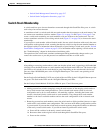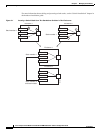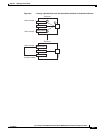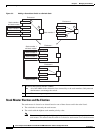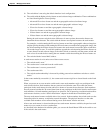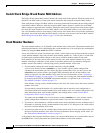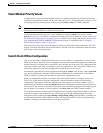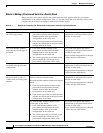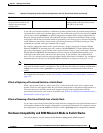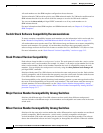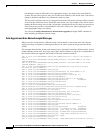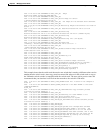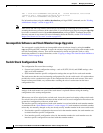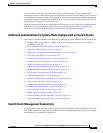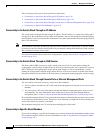
5-11
Cisco Catalyst Switch Module 3110 and 3012 for IBM BladeCenter Software Configuration Guide
OL-12189-01
Chapter 5 Managing Switch Stacks
Understanding Switch Stacks
If you add a provisioned switch that is a different type than specified in the provisioned configuration to
a powered-down switch stack and then apply power, the switch stack rejects the (now incorrect) switch
stack-member-number provision type global configuration command in the startup configuration file.
However, during stack initialization, the nondefault interface configuration information in the startup
configuration file for the provisioned interfaces (potentially of the wrong type) is executed. Depending
on the differences between the actual switch type and the previously provisioned switch type, some
commands are rejected, and some commands are accepted.
For example, suppose the switch stack is provisioned for a 18-port switch with 14 internal Gigabit
Ethernet 1000BASE-X downlink ports and 4 external 10/100/1000BASE-T Gigabit Ethernet uplink
ports, the configuration is saved, and the stack is powered down. Then a 15-port switch with 14 internal
Gigabit Ethernet 1000BASE-X downlink ports and one external 10-Gigabit Ethernet uplink port is
connected to the switch stack, and the stack is powered up. In this situation, the configuration for
ports 15 to 18 is rejected, and error messages appear during initialization. In addition, any configured
commands that are valid only on the Gigabit Ethernet interfaces are rejects, even for ports 1 to 14.
Note If the switch stack does not contain a provisioned configuration for a new switch, the switch joins the
stack with the default interface configuration. The switch stack then adds to its running configuration a
switch stack-member-number provision type global configuration command that matches the new
switch.
For configuration information, see the “Provisioning a New Member for a Switch Stack” section on
page 5-25.
Effects of Replacing a Provisioned Switch in a Switch Stack
When a provisioned switch in a switch stack fails, is removed from the stack, and is replaced with
another switch, the stack applies either the provisioned configuration or the default configuration to it.
The events that occur when the switch stack compares the provisioned configuration with the
provisioned switch are the same as those described in the “Effects of Adding a Provisioned Switch to a
Switch Stack” section on page 5-10.
Effects of Removing a Provisioned Switch from a Switch Stack
If you remove a provisioned switch from the switch stack, the configuration associated with the removed
stack member remains in the running configuration as provisioned information. To completely remove
the configuration, use the no switch stack-member-number provision global configuration command.
Hardware Compatibility and SDM Mismatch Mode in Switch Stacks
The switch supports only the desktop Switch Database Management (SDM) templates.
The stack member number of
the provisioned switch is not
found in the provisioned
configuration.
The switch stack applies the default
configuration to the provisioned switch
and adds it to the stack.
Table 5-1 Results of Comparing the Provisioned Configuration with the Provisioned Switch (continued)
Scenario Result



